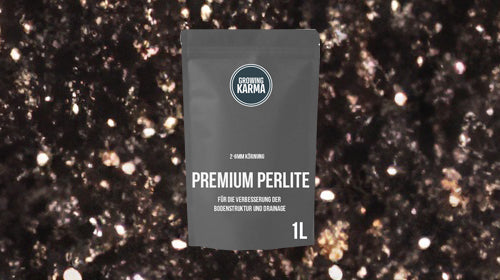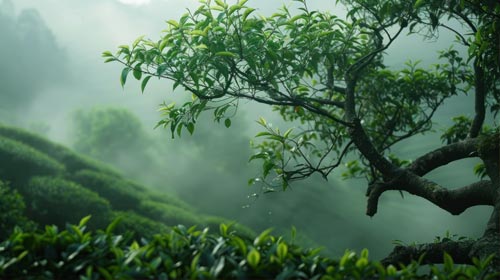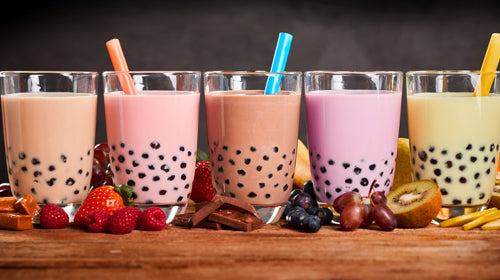Perlite for tea plants: Why it is the basis for healthy growth
Anyone who wants to grow tea not only needs robust plants, but above all the right substrate. Especially in the first one to five years, soil structure is crucial for the development of healthy roots and strong shoots. At Growing Karma, we specifically use perlite for tea – and with great success.
In this article, you will learn why perlite is so suitable for tea plants, how it works, and how you can best use it if you want to grow tea yourself – whether in a pot, raised bed, or in the garden.
What is perlite?
Perlite is a naturally occurring volcanic rock with a high silica content. Rapid heating to over 1,000°C causes it to expand—similar to popcorn. The result is small, white, porous spheres with unique physical properties:
- extremely light
- pH-neutral
- sterile (free from germs and fungi)
- very high water storage capacity
- excellent drainage properties
It's precisely this combination that makes perlite so valuable for plants —especially young, delicate tea plants. It improves soil structure, ensures stable aeration in the root zone, and simultaneously keeps water available without causing waterlogging.
Why perlite is so important for tea cultivation
Tea plants ( Camellia sinensis ) are sensitive to soil compaction, standing water, or nutrient imbalances. Especially in the first few years—from cutting to established shrub—aerated, well-drained soil is crucial. This is where perlite comes into its own:
Benefits of perlite for tea plants:
- Structural improvement: Perlite loosens heavy substrates and prevents soil compaction.
- Optimal drainage: Excess water drains away quickly, the roots remain dry enough.
- Water retention: Despite its good permeability, perlite retains water in its pores – ideal for consistent moisture.
- Aeration of the root zone: Oxygen supply is essential for root growth – perlite promotes it specifically.
- Long-term stability: Unlike organic materials, perlite does not decompose – it remains active for years.
Perlite is almost indispensable, especially when growing tea in pots or containers —for example, on a balcony, terrace, or in a greenhouse. It can also significantly improve existing soils outdoors.
Our experience at Growing Karma
On our permaculture plots in Germany, we have years of experience with tea plants – under natural conditions, outdoors, in pots, and in greenhouses. We almost always use a perlite-rich substrate during the cultivation phase.
The results:
- Root balls are loose and well ventilated
- Plants are less sensitive to dry periods
- Growth behavior is more stable and uniform
- Risk of root rot or waterlogging is drastically reduced
Our proven substrate mix for young tea plants:
- Peat-free, loose compost soil
- 20–30% perlite (fine to medium-coarse)
- Fine pine bark for environmental stabilization and structural improvement
We use this mixture both in pots and for new plantings in the garden – with excellent results.
How to use perlite correctly in tea cultivation
The application of perlite is simple – and can be flexibly adapted to your circumstances:
1. When mixing potting soil:
Mix about 20 to 30% perlite into your soil. For very heavy soils, you can increase the proportion to 40%.
2. In a pot or container:
Place a drainage layer of perlite on the bottom of the pot (approx. 2–3 cm). This effectively prevents standing water.
3. When repotting:
Make sure you use a well-mixed substrate with a high perlite content to provide ideal conditions for young roots.
4. In the field:
In clayey or compacted soils, you can work perlite into the soil over a large area or in specific areas to permanently improve the soil structure.
Good to know: Perlite is durable, does not lose its effectiveness and does not need to be replaced regularly.
Conclusion: Perlite is the invisible helper in tea cultivation
Anyone who wants to successfully cultivate tea should pay the same attention to the substrate as they do to the plant itself. Perlite for tea is more than just a supplement—it is a fundamental requirement for healthy, strong plants, especially during the sensitive initial phase.
Our experience at Growing Karma shows that with the right mix of compost, pine bark, and perlite, tea plants not only grow better—they become more resilient, more vital, and longer-lasting. A sustainable start that pays off.
FAQ – Frequently asked questions about perlite in tea cultivation
Is perlite also suitable for organic tea?
Yes. Perlite is a purely mineral, natural product—it is chemically inert, contains no pollutants, and is therefore also suitable for organic farming.
How much perlite should I use?
Generally, 20–30% perlite in the substrate is ideal. For very heavy soils or particularly sensitive young plants, the proportion can be slightly higher.
Can I use perlite in existing garden soil?
Yes. Perlite can be added to compacted or water-prone soils to permanently improve soil structure.
Where can I get suitable perlite for plants?
You can find perlite in well-stocked garden centers, nurseries, or directly from Growing Karma – we focus on high-quality, natural perlite without chemical additives.
If you have any questions about the optimal substrate mix or are looking for a suitable product, we will be happy to help you.




Leave a comment
This site is protected by hCaptcha and the hCaptcha Privacy Policy and Terms of Service apply.